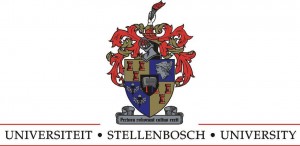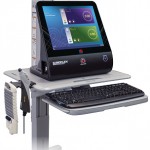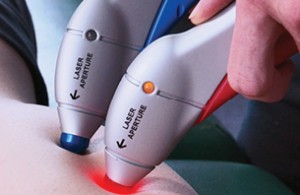Preamble
In this time of an unprecedented historical crisis, few individuals are able to continue thinking independently while also retaining some sense of balance, and most importantly, common sense. Hopefully some of us are able to cling to these characteristics at a time when reason appears to be lost, and when many politicians and other spokespersons provide many conflicting and confusing directives.
Personally, I am a firm believer in at least one-half hour of daily vigorous exercise, balanced nutrition, and attempting to be active without endangering others. This permits time for reflection.
Over the past weeks, I have received numerous inquiries from healthcare professionals that are trained in Laser Therapy whether they should apply this treatment to patients afflicted with a variety of symptoms, secondary to COVID-19, and most particularly concerning respiratory problems.
It is my personal opinion that this course of action could be highly beneficial, although no large-scale studies have been performed to date.
Over the past decade, the clinical staff at Meditech has treated many patients demonstrating an extensive variety of pulmonary diseases characterized by inflammation, fibrosis, and obstruction. This results in limitation of respiratory capacity and inadequate oxygenation of the blood and therefore the tissues. The conditions treated include those inflammatory in nature, chronic obstructive pulmonary disease, etc. In treating these entities we have had almost universal positive results, however for regulatory reasons, we have not promoted this particular therapeutic approach. As we all know, healthcare today is governed by the insurance companies, politicians, and regulatory bodies while the medical profession has become obsequious to these entities. Practitioners have been forced to rely on codes, equivalent to “speaking in tongues”, which have no particular relationship to quality therapy and are completely related to economic factors.
On April 18th, I happened to watch a television program from Italy which has prompted this presentation. The content featured two Italian ICU specialists, both of whom were highly knowledgeable and demonstrated the type of reflection that is so important at this stage of our international dilemma. The discussion revolved around the process of intubation, induced coma, and the widespread use of mechanical respirators in the treatment of pulmonary pathology secondary to COVID-19 infections. These doctors’ comments were apolitical and a true revelation, more significant than any others I have recently heard. The ICU doctors indicated that the above approach resulted in an unacceptable level of morbidity and mortality, a fact which was of no surprise to me. Mechanical respiration and intubation imply significant trauma, particularly in the hands of therapists that may be inexpert in their administration. Lungs affected by the virus are severely inflamed, filled with viscous fluid, and are surrounded by fibrotic and necrotic tissue which severely limits the exchange of gases. The lungs are inelastic and forcing expansion can lead to disastrous results. Clearly, even in the best of hands, this may not be a rational or an elegant approach, although generally applied with the best of intentions.
On the other hand, Laser Therapy has been established over the past 50 years and consistently accelerates the healing process in tissue. With regard to the COVID-19 pathologies in the lungs, the following physiological effects conferred by Laser Therapy would be of immense value i.e.:
- Elevation of the immune response.
- Potent anti-inflammatory effect.
- Improved metabolism of the individual cells.
- Increased production of endorphins.
- Regeneration of new cells.
- Restoration of normal structure and function of existing cells.
- Increased cortisol production which is the precursor of cortisone within the body.
Numerous additional physiological activities which are highly beneficial occur concomitantly. Both local and systemic effects are actualized, and these represent significant factors in the healing process.
Advantages of the Application of Laser Therapy
Technicians can be trained to utilize the equipment with 2-3 hours of training.
Protection of the health care worker’s exposure is facilitated.
Therapy can be started immediately.
There are no adverse effects associated with this therapeutic approach.
The clinical benefits begin to be realized concurrent to application.
At Meditech we have established a group of clinicians and therapists, all of whom share these views and objectives. As a physician, I have always been motivated to help those in need and there is no better time to move forward than the present.
Application of Laser Therapy to the Pulmonary Structures
The entire lung can be irradiated in the course of an hour-long treatment, utilizing large surface arrays powered by specially manufactured SLD’s.
This process can be followed by the application of a 200mw infrared laser probe directed at the most severely affected areas of pathology.
Application time in the most acute case would require 1 hour of Laser Therapy in the morning, and 1 hour late in the day.
Laser Therapy to the cervical spine may also be incorporated during the course of treatment for purposes of neuro-modulation.
In conclusion, I will summarize what I have already stated; Laser Therapy can be instituted immediately, and the effects will be apparent both systemically and locally as soon as therapy has been initiated.
Fred Kahn, MD, FRCS(C)
CEO and President of Meditech International Inc.
Effects on Anatomical Structures
Musculoskeletal (rib cage)
- Diminishes inflammation of intercostal musculature
- Reduced muscle spasm
- Facilitates lactic acid removal
- Improvement of muscular contractions increasing the ability to breathe more normally
Sternum
- Improved replication of cells that can potentially destroy the virus directly and remove necrotic tissue.
Lung Parenchyma
- Inflammation reduced
- Exchange of gases facilitated in alveoli
- Fluid retention relieved, allowing improved functional capacity
Cervical Spine, Cerebellum, and Brain Stem – Neuromodulation
- Reduced anxiety
- Depression gradually lifted
- Mood elevation
- Restoration of sleep patterns
Tips – Re: Application of Therapy to Lungs
- Focus on radiation over the lung tissue that is most accessible, i.e. bases of lungs, apices, and axillary areas.
- Minimal treatment over scapulae, cardiac region, and sternum, but these areas do require treatment.
Protocols
- L-S Array; 3 minutes Red, 5 minutes Infrared over areas where parenchyma is readily accessible.
- L-S Array; 2 minutes Red, 4 minutes Infrared over cardiac area, sternum, scapulae, and thoracic spine.
Initial Protocol Settings
Stage 1
Red continuous / Infrared, frequency 50/duty cycle 80; total treatment time approximately 1 hour.
If immediate response is good, continue with these settings.
If progress is slow, after two treatments one may advance to Stage 2.
Stage 2;
Red frequency 100/ duty cycle 90, Infrared frequency 50/ duty cycle 90
Stage 3;
Red frequency 1000/ duty cycle 80, Infrared frequency 250/ duty cycle 80
Stage 4;
Red frequency 1000/ duty cycle 90, Infrared frequency 250/ duty cycle 90
Stage 5;
Red frequency 10,000/ duty cycle 70, Infrared frequency 5,000/ duty cycle 80.
Treatments can be applied in accord with severity of the clinical symptoms and the patients’ overall status.
In moderate cases, 1 to 2 hour long individual daily treatments suggested.
In severe cases, Therapy every 8 hours may be advisable.
In all cases, one may remain at whatever Stage is providing the best clinical response. A good clinician will always be able to easily move from one Stage to the next, depending on correlation of changes in the patient’s condition.
The IR Laser Probe can be applied for 10-20 minutes in areas where consolidation of the lungs is noted to be most severe. Usually apply in continuous mode.
Anterior View Of Rib Cage (Lungs)
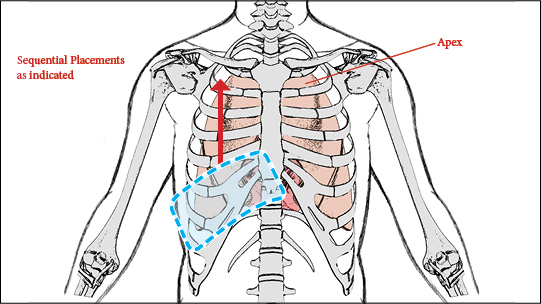
Posterior View Of Rib Cage (Lungs)

Cervical Spine Placement Of Arrays
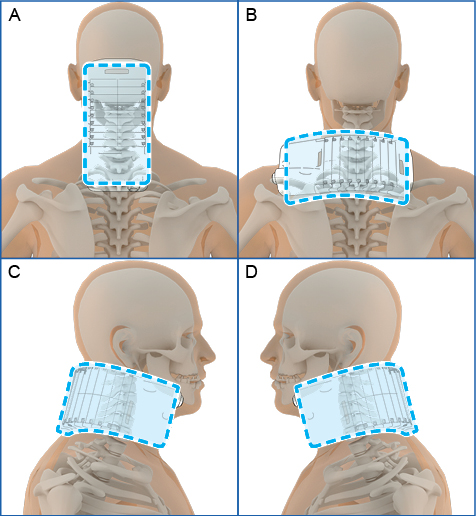
- Using arrays over the four positions is preferable in most cases
(i.e. A, B, C & D).
Protocols For Cervical Spine (Cerebellum , Brain Stem)
| Stage One: |
| Treatment Head |
Frequency |
Duty Cycle |
Duration (mins) |
Power % |
DUO Red
DUO Infrared
LD-R 100
LD-I 200
|
CW
50
CW
CW
|
50
|
4/4/4/4
5/5/5/5
6
6
|
50
25-50
|
| Stage Two: |
| Treatment Head |
Frequency |
Duty Cycle |
Duration (mins) |
Power % |
DUO Red
DUO Infrared
LD-R 100
LD-I 200
|
CW
50
CW
CW
|
70
|
4/4/4/4
5/5/5/5
6
6
|
100
25-50
|
| Stage Three: |
| Treatment Head |
Frequency |
Duty Cycle |
Duration (mins) |
Power % |
DUO Red
DUO Infrared
LD-R 100
LD-I 200
|
100
50
CW
CW
|
70-90
80
|
4/4/4/4
5/5/5/5
6
6
|
100
50-100
|
| Stage Four: |
| Treatment Head |
Frequency |
Duty Cycle |
Duration (mins) |
Power % |
DUO Red
DUO Infrared
LD-R 100
LD-I 200
|
100
50
CW
CW
|
80
80
|
4/4/4/4
5/5/5/5
6
6
|
100
100
|
If you require any further information, please do not hesitate to contact us immediately.
(This presentation is specifically intended for the treatment of patients who are hospitalized.
At the same time it can be used to prevent progress of presumed early symptoms of the disease following
medical assessment.)




